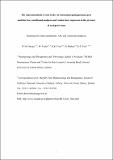| dc.contributor.author | Olango, W.M. | |
| dc.contributor.author | Roche, Michelle | |
| dc.contributor.author | Ford, Gemma K. | |
| dc.contributor.author | Harhen, Brendan | |
| dc.contributor.author | Finn, David P. | |
| dc.date.accessioned | 2012-01-24T10:25:25Z | |
| dc.date.available | 2013-01-21T13:13:49Z | |
| dc.date.issued | 2011 | |
| dc.identifier.citation | Olango WM, Roche M, Ford GK, Harhen B, Finn DP (2011). The endocannabinoid system in the rat dorsolateral periaqueductal grey mediates fear-conditioned analgesia and controls fear expression in the presence of nocicpetive tone. British Journal of Pharmacology | en_US |
| dc.identifier.uri | http://hdl.handle.net/10379/2526 | |
| dc.description.abstract | Background and purpose: Endocannabinoids in the midbrain periaqueductal grey (PAG) are involved in modulating nociception and unconditioned stress-induced analgesia, however, their role in fear-conditioned analgesia (FCA) has not been examined. The present study examined the role of the endocannabinoid system in the dorsolateral (dl) PAG in formalin-evoked nociceptive behaviour, conditioned fear and FCA in rats.
Experimental approach: Rats received intra-dlPAG administration of the CB1 receptor antagonist/inverse agonist rimonabant, or vehicle, prior to re-exposure to a context paired 24hrs previously with footshock. Formalin-evoked nociceptive behaviour and fear-related behaviours (freezing and 22kHz ultrasonic vocalisation) were assessed. In a separate cohort, alterations in levels of endocannabinoids (2-arachidonoyl glycerol [2-AG] and N-arachidonoyl ethanolamide [anandamide; AEA]) and the related N-acylethanolamines (NAEs) (N-palmitoyl ethanolamide [PEA] and N-oleoyl ethanolamide [OEA]) were measured in dlPAG tissue following re-exposure to conditioned context in the presence or absence of formalin-evoked nociceptive tone.
Key results: Re-exposure of rats to the context previously associated with footshock resulted in FCA. Intra-dlPAG administration of rimonabant significantly attenuated FCA and fear-related behaviours expressed in the presence of nociceptive tone. Conditioned fear in the absence of formalin-evoked nociceptive tone was associated with increased levels of the endocannabinoids (2-AG and AEA) and NAEs (PEA and OEA) in the dlPAG. FCA was specifically associated with an increase in AEA levels in the dlPAG.
Conclusions and implications: These data suggest that conditioned fear to context mobilises endocannabinoids and NAEs in the dlPAG and support a role for the endocannabinoid system in the dlPAG in mediating the potent suppression of pain responding which occurs during exposure to conditioned aversive contexts. | en_US |
| dc.format | application/pdf | en_US |
| dc.language.iso | en | en_US |
| dc.publisher | Wiley | en_US |
| dc.rights | Attribution-NonCommercial-NoDerivs 3.0 Ireland | |
| dc.rights.uri | https://creativecommons.org/licenses/by-nc-nd/3.0/ie/ | |
| dc.subject | Pain | en_US |
| dc.subject | Fear | en_US |
| dc.subject | Cannabinoid type 1 (CB1) receptor | en_US |
| dc.subject | Endocannabinoids | en_US |
| dc.subject | N-acylethanolamines | en_US |
| dc.subject | Periaqueductal grey | en_US |
| dc.subject | Rats | en_US |
| dc.subject | Pharmacology & Therapeutics | en_US |
| dc.title | The endocannabinoid system in the rat dorsolateral periaqueductal grey mediates fear-conditioned analgesia and controls fear expression in the presence of nocicpetive tone | en_US |
| dc.type | Article | en_US |
| dc.local.publishedsource | http://dx.doi.org/10.1111/j.1476-5381.2011.01478.x | en_US |
| dc.description.peer-reviewed | peer-reviewed | en_US |
| dc.contributor.funder | SFI | en_US |
| nui.item.downloads | 707 | |


